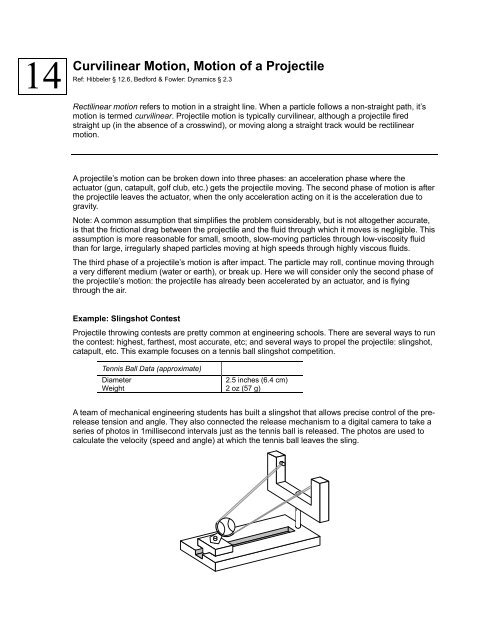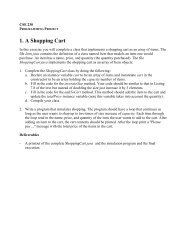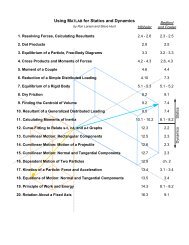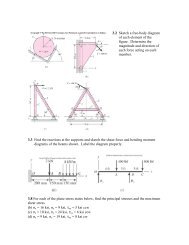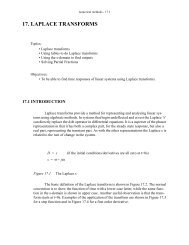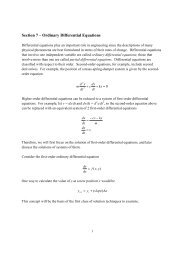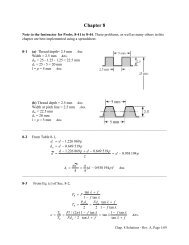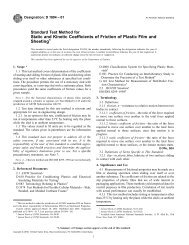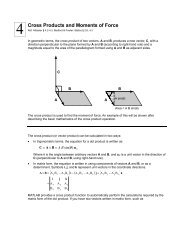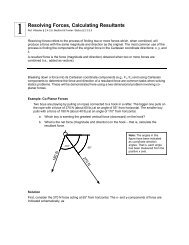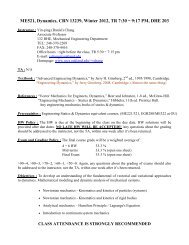14 Curvilinear Motion, Motion of a Projectile
14 Curvilinear Motion, Motion of a Projectile
14 Curvilinear Motion, Motion of a Projectile
You also want an ePaper? Increase the reach of your titles
YUMPU automatically turns print PDFs into web optimized ePapers that Google loves.
<strong>14</strong><br />
<strong>Curvilinear</strong> <strong>Motion</strong>, <strong>Motion</strong> <strong>of</strong> a <strong>Projectile</strong><br />
Ref: Hibbeler § 12.6, Bedford & Fowler: Dynamics § 2.3<br />
Rectilinear motion refers to motion in a straight line. When a particle follows a non-straight path, it’s<br />
motion is termed curvilinear. <strong>Projectile</strong> motion is typically curvilinear, although a projectile fired<br />
straight up (in the absence <strong>of</strong> a crosswind), or moving along a straight track would be rectilinear<br />
motion.<br />
A projectile’s motion can be broken down into three phases: an acceleration phase where the<br />
actuator (gun, catapult, golf club, etc.) gets the projectile moving. The second phase <strong>of</strong> motion is after<br />
the projectile leaves the actuator, when the only acceleration acting on it is the acceleration due to<br />
gravity.<br />
Note: A common assumption that simplifies the problem considerably, but is not altogether accurate,<br />
is that the frictional drag between the projectile and the fluid through which it moves is negligible. This<br />
assumption is more reasonable for small, smooth, slow-moving particles through low-viscosity fluid<br />
than for large, irregularly shaped particles moving at high speeds through highly viscous fluids.<br />
The third phase <strong>of</strong> a projectile’s motion is after impact. The particle may roll, continue moving through<br />
a very different medium (water or earth), or break up. Here we will consider only the second phase <strong>of</strong><br />
the projectile’s motion: the projectile has already been accelerated by an actuator, and is flying<br />
through the air.<br />
Example: Slingshot Contest<br />
<strong>Projectile</strong> throwing contests are pretty common at engineering schools. There are several ways to run<br />
the contest: highest, farthest, most accurate, etc; and several ways to propel the projectile: slingshot,<br />
catapult, etc. This example focuses on a tennis ball slingshot competition.<br />
Tennis Ball Data (approximate)<br />
Diameter<br />
2.5 inches (6.4 cm)<br />
Weight 2 oz (57 g)<br />
A team <strong>of</strong> mechanical engineering students has built a slingshot that allows precise control <strong>of</strong> the prerelease<br />
tension and angle. They also connected the release mechanism to a digital camera to take a<br />
series <strong>of</strong> photos in 1millisecond intervals just as the tennis ball is released. The photos are used to<br />
calculate the velocity (speed and angle) at which the tennis ball leaves the sling.
A test run with the camera operational gave the following set <strong>of</strong> photos (superimposed).<br />
25°<br />
0 20 40 60 mm<br />
Part 1.<br />
Determine:<br />
a. The initial velocity <strong>of</strong> the tennis ball as it leaves the sling.<br />
b. The predicted time <strong>of</strong> flight for the ball.<br />
c. The predicted horizontal travel distance for the ball.<br />
Part 2.<br />
The team that gets most balls into a basket set 30 meters from the launch site wins. If they can keep<br />
the initial speed constant (at the test run value <strong>of</strong> 22.1 m/s), what angle should they use to shoot the<br />
tennis balls into the basket?<br />
Part 1. Solution<br />
The initial velocity is calculated from the 60 mm horizontal travel distance observed in the photos<br />
using the camera’s 1 millisecond interval between snapshots.<br />
» x_test = 60 / 1000; %Horizontal travel distance for all four frames (m)<br />
» theta = 25 * pi/180; %Angle <strong>of</strong> trajectory (radians)<br />
» d_test = x_test / cos(theta) %Distance ball traveled in direction <strong>of</strong> motion (m)<br />
d_test =<br />
0.0662<br />
» dt_pic = 0.001; %Interval between snapshots (s)<br />
» dt_test = 3 * dt_pic; %3 time intervals between the four photos<br />
» v_int = d_test / dt_test %Initial velocity <strong>of</strong> the tennis ball<br />
v_int =<br />
22.0676<br />
The horizontal and vertical components <strong>of</strong> the initial velocity will be useful for later calculations.<br />
» v_yint = v_int * sin(theta) %y component <strong>of</strong> initial velocity
v_yint =<br />
9.3262<br />
» v_xint = v_int * cos(theta) %x component <strong>of</strong> initial velocity<br />
v_xint =<br />
20<br />
» v_x = v_xint %x component <strong>of</strong> velocity is constant (if air resistance is ignored)<br />
v_x =<br />
20<br />
The predicted time <strong>of</strong> flight can be calculated using<br />
1<br />
2<br />
0 + v y _ init t flight a<br />
2 c t flight<br />
y = y<br />
+<br />
where a c is the constant acceleration. In this problem, the acceleration is due to gravity and acts in<br />
the –y direction, so a c = -g.<br />
If we assume that the flight is over a horizontal surface, then y at the end <strong>of</strong> the flight is zero. Another<br />
common assumption is to assume that y 0 is also zero. This is a reasonable assumption if the vertical<br />
position <strong>of</strong> the tennis ball as it leaves the sling is small compared to the maximum height reached<br />
during the flight.<br />
With these assumptions, the equation can be solved for the time <strong>of</strong> flight<br />
t<br />
flight<br />
−2 v<br />
=<br />
a<br />
y _ init<br />
c<br />
Using MATLAB, the time <strong>of</strong> flight is predicted to be 1.9 seconds.<br />
» a_c = -9.8; %The constant acceleration in this problem is due to gravity<br />
» t_flight= -2 * v_yint / a_c<br />
t_flight =<br />
1.9033<br />
We can calculate the maximum height to see if the assumption that y 0 is negligible is reasonable. The<br />
maximum height occurs at ½ the flight time (if y 0 =y final , and air resistance is negligible).<br />
» y_o = 0;<br />
» y_final = 0;<br />
» y_max = y_o + v_yint * t_flight / 2 + a_c / 2 * ( t_flight/2 )^2<br />
y_max =<br />
4.4376<br />
Looking at the drawing <strong>of</strong> the slingshot, the ball is released at a height about two or three times the<br />
ball diameter, around 15 to 20 cm. 20 cm is nearly 5% <strong>of</strong> y max . That is probably negligible, but we can<br />
use MATLAB’s root finder to find t flight including y 0 = 20 cm.
» y_o = 20 / 100; %Initial height (m)<br />
» y_final = 0; %Final height (m)<br />
» coeffs = [( a_c/2 ) ( v_yint ) ( y_o - y_final )]; %Polynomial<br />
» t_flight= roots(coeffs) %Roots<br />
t_flight =<br />
1.9245<br />
-0.0212<br />
» t_flight= t_flight(1) %Choose positive root<br />
t_flight =<br />
1.9245<br />
Note: See the annotated MATLAB Script Solution for a more complete explanation <strong>of</strong> MATLAB’s<br />
roots function and how MATLAB represents polynomials.<br />
Accounting for the initial height increased the predicted flight time from 1.902 to 1.925 seconds (about<br />
1% difference).<br />
Finally, we calculate the predicted horizontal travel distance.<br />
» x_o = 0; %Initial horizontal position<br />
» x = x_o + v_x * t_flight<br />
x =<br />
38.4901
Annotated MATLAB Script Solution<br />
%%%%%%%%%%%%%%%%%%%%%%%%%%%%%%%%%%%%%%%%%%%%%%%%%%%%%%%%%%%%%%%%%%%%%%%%%%<br />
%<strong>Projectile</strong> <strong>Motion</strong>: Slingshot Contest<br />
%Calculate Initial Velocity from Test Run<br />
%%%%%%%%%%%%%%%%%%%%%%%%%%%%%%%%%%%%%%%%%%%%%%%%%%%%%%%%%%%%%%%%%%%%%%%%%%<br />
%Horizontal travel distance for all four frames (m)<br />
x_test = 60 / 1000;<br />
%Angle <strong>of</strong> trajectory (radians)<br />
theta = 25 * pi/180;<br />
%distance ball traveled in direction <strong>of</strong> motion (m)<br />
d_test = x_test / cos(theta);<br />
fprintf('Distance ball traveled in direction <strong>of</strong> motion = %1.4fm\n',d_test)<br />
%Interval between snapshots (s)<br />
dt_pic = 0.001;<br />
%3 time intervals between the four photos<br />
dt_test = 3 * dt_pic;<br />
%Initial velocity <strong>of</strong> the tennis ball<br />
v_int = d_test / dt_test;<br />
fprintf('Initial velocity = %3.1f m/s\n',v_int)<br />
%y component <strong>of</strong> initial velocity<br />
v_yint = v_int * sin(theta);<br />
fprintf('\ty component = %3.1f m/s\n',v_yint)<br />
%x component <strong>of</strong> initial velocity<br />
v_xint = v_int * cos(theta);<br />
fprintf('\tx component = %3.1f m/s\n\n',v_xint)<br />
%x component <strong>of</strong> velocity is constant (if air resistance is ignored)<br />
v_x = v_xint;<br />
%%%%%%%%%%%%%%%%%%%%%%%%%%%%%%%%%%%%%%%%%%%%%%%%%%%%%%%%%%%%%%%%%%%%%%%%%%<br />
%Calculate Time <strong>of</strong> Flight<br />
%%%%%%%%%%%%%%%%%%%%%%%%%%%%%%%%%%%%%%%%%%%%%%%%%%%%%%%%%%%%%%%%%%%%%%%%%%<br />
%The constant acceleration in this problem is due to gravity<br />
a_c = -9.8;<br />
t_flight= -2 * v_yint / a_c;<br />
fprintf('Flight time (Ignoring y_o) = %3.3f s\n',t_flight)<br />
y_o = 0; %Initial height<br />
y_final = 0;<br />
%Final height<br />
y_max = y_o + v_yint * t_flight/2 + a_c/2 * ( t_flight/2 )^2;<br />
fprintf('y_max = %3.1f m\n\n',y_max)<br />
continues…
%%%%%%%%%%%%%%%%%%%%%%%%%%%%%%%%%%%%%%%%%%%%%%%%%%%%%%%%%%%%%%%%%%%%%%%%%%<br />
%Alternative Solution Method - Include y_o and use MATLAB's root finder<br />
%%%%%%%%%%%%%%%%%%%%%%%%%%%%%%%%%%%%%%%%%%%%%%%%%%%%%%%%%%%%%%%%%%%%%%%%%%<br />
%<br />
%The predicted time <strong>of</strong> flight can be calculated using<br />
% y_max = y_o + v_yint * t_flight + a_c/2 * t_flight^2<br />
%<br />
%This equation is a second order polynomial in t_flight and can be<br />
%rewritten in the form<br />
% 0 = a2 * x^2 + a1 * x + a0<br />
% with<br />
% a2 = a_c/2<br />
% a1 = v_yint<br />
% a0 = y_o - y_final<br />
%<br />
%Polynomials are represented in MATLAB by an array <strong>of</strong> the<br />
%coefficients in descending order. Therefore, this polynomial<br />
%would be represented by the following<br />
% coefficients = [a2 a1 a0]<br />
% or<br />
% coefficients = [( a_c/2 ) ( v_yint ) ( y_o - y_final )];<br />
y_o = 20 / 100; %Initial height (m)<br />
y_final = 0;<br />
%Final height (m)<br />
coeffs = [( a_c/2 ) ( v_yint ) ( y_o - y_final )]; %Polynomial<br />
t_flight= roots(coeffs);<br />
%Roots<br />
t_flight= t_flight(1);<br />
%Choose the positive root<br />
fprintf('Alternative Solution Method - Include y_o and use MATLAB''s root<br />
finder\n')<br />
fprintf('Flight time = %3.3f s\n',t_flight)<br />
%%%%%%%%%%%%%%%%%%%%%%%%%%%%%%%%%%%%%%%%%%%%%%%%%%%%%%%%%%%%%%%%%%%%%%%%%%<br />
%Calculate Horizontal <strong>Motion</strong><br />
%%%%%%%%%%%%%%%%%%%%%%%%%%%%%%%%%%%%%%%%%%%%%%%%%%%%%%%%%%%%%%%%%%%%%%%%%%<br />
x_o = 0;<br />
x = x_o + v_x * t_flight;<br />
fprintf('Horizontal <strong>Motion</strong> = %3.3f m\n',x)<br />
Part 2.<br />
With the MATLAB Script, we can simply try some different angles until we calculate a predicted<br />
horizontal travel distance <strong>of</strong> 30 meters.<br />
First, try 20 degrees.
%%%%%%%%%%%%%%%%%%%%%%%%%%%%%%%%%%%%%%%%%%%%%%%%%%%%%%%%%%%%%%%%%%%%%%%%%%<br />
%Calculate Inital Velocity Components<br />
%%%%%%%%%%%%%%%%%%%%%%%%%%%%%%%%%%%%%%%%%%%%%%%%%%%%%%%%%%%%%%%%%%%%%%%%%%<br />
%Initial velocity <strong>of</strong> the tennis ball<br />
v_int = 22.1;<br />
%Angle <strong>of</strong> trajectory (radians)<br />
theta = 20 * pi/180;<br />
fprintf('Initial velocity = %3.1f m/s\t\t',v_int)<br />
fprintf('Angle <strong>of</strong> trajectory = %3.2f deg\n',theta * 180/pi)<br />
%y component <strong>of</strong> initial velocity<br />
v_yint = v_int * sin(theta);<br />
fprintf('\ty component = %3.1f m/s\n',v_yint)<br />
%x component <strong>of</strong> initial velocity<br />
v_xint = v_int * cos(theta);<br />
fprintf('\tx component = %3.1f m/s\n\n',v_xint)<br />
%x component <strong>of</strong> velocity is constant (if air resistance is ignored)<br />
v_x = v_xint;<br />
%%%%%%%%%%%%%%%%%%%%%%%%%%%%%%%%%%%%%%%%%%%%%%%%%%%%%%%%%%%%%%%%%%%%%%%%%%<br />
%Calculate Time <strong>of</strong> Flight<br />
%%%%%%%%%%%%%%%%%%%%%%%%%%%%%%%%%%%%%%%%%%%%%%%%%%%%%%%%%%%%%%%%%%%%%%%%%%<br />
%The constant acceleration in this problem is due to gravity<br />
a_c = -9.8;<br />
t_flight= -2 * v_yint / a_c;<br />
fprintf('Flight time (Ignoring y_o) = %3.3f s\n',t_flight)<br />
%%%%%%%%%%%%%%%%%%%%%%%%%%%%%%%%%%%%%%%%%%%%%%%%%%%%%%%%%%%%%%%%%%%%%%%%%%<br />
%Calculate Horizontal <strong>Motion</strong><br />
%%%%%%%%%%%%%%%%%%%%%%%%%%%%%%%%%%%%%%%%%%%%%%%%%%%%%%%%%%%%%%%%%%%%%%%%%%<br />
x_o = 0;<br />
x = x_o + v_x * t_flight;<br />
fprintf('Horizontal <strong>Motion</strong> = %3.3f m\n',x)<br />
MATLAB Output<br />
Initial velocity = 22.1 m/s<br />
y component = 7.6 m/s<br />
x component = 20.8 m/s<br />
Angle <strong>of</strong> trajectory = 20.00 deg<br />
Flight time (Ignoring y_o) = 1.543 s<br />
Horizontal <strong>Motion</strong> = 32.035 m<br />
With a little trial and error, the predicted angle should be 18.5 degrees.


